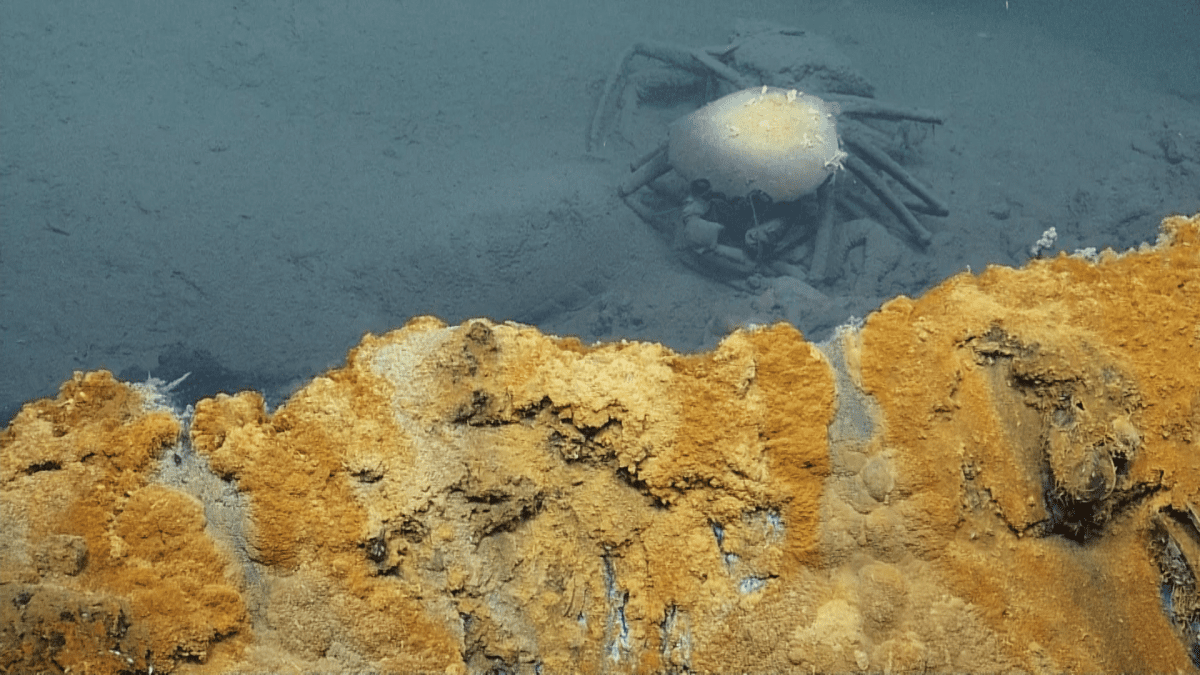
Often the ocean can look idyllic and inviting on the surface. Exploration of the sea floor, however, shows a harsh and unforgiving place. The Gulf of Mexico brine pools investigated by Erik Cordes and his colleagues are a model example. Subject to salinity more than four times the amount of normal seawater, and full of toxic compounds, it is hard to imagine a more hostile habitat. The pools are so desolate they have garnered the nickname the “Jacuzzi of Despair.†Despite such severe conditions certain creatures can live or even thrive in close proximity; mussels make their home along the edge, and fish skim the surface. While life exists on the periphery of the pools, any animal that ventures into the brine will not survive.
Exploration of the brine pool
Brine pools form through a geologic process known as salt tectonics. Long ago the Gulf of Mexico was a shallow sea which was cut off from the rest of the ocean and dried out. This caused the salt in the seawater to crystalize as the liquid evaporated. The salt was then covered by sediment and compressed into an underlying layer. Eventually worldwide sea levels rose again filling the gulf. The additional water increased the pressure on the sediment layers causing salt to seep through cracks and recombine with the liquid above. This process resulted in a brine so dense that it was incompatible with the surrounding seawater and created a visible “lake†within the ocean.
Remotely operated vehicle dips into brine pool
The bizarre phenomena of a lake at the bottom of the ocean is known as a halocline, a visible boundary between two fluids. Haloclines occur in areas where differences in salinity, and therefore density, separate two bodies of water. This density disparity is what produces the visual effect of a pool underneath the water. Disturbing the surface of the pool can even create waves. Haloclines can be found all around the world, especially in areas where two separate bodies of water meet.
Among the pools' other strange attributes is the composition. The brine's high salt content is caustic to marine organisms. Toxic compounds such as methane and sulfide are dissolved into the brine while the immense pressure 3300ft below the surface reduces the available oxygen.
These conditions create a nearly uninhabitable environment. Yet mussels use this location to their advantage, with the help of specialized bacteria. Bacteria in the mussel's gills use chemosynthesis to convert methane and sulfide into energy. The bacteria are provided a place to live, and the mussels can use the energy created by the bacteria to grow. This exchange makes it viable for the mussels to exist in such an uninviting place. Unfortunately, large organisms that fall into the pool suffocate from the lack of oxygen. Then, like pickling a cucumber, the salt causes water to leach from the organism's cells, preserving them indefinitely. Their bodies remain as a warning for any who might try to venture in.

The Gulf of Mexico brine pools are a fascinating discovery but they can also lead to a greater understanding of the natural world. This knowledge can in turn be useful for developing new technology. Perhaps chemosynthetic organisms can lead us to new processes for creating energy. Alternatively extremophiles, like methane breathing bacteria, could inform our search for extraterrestrial life. Environments like the brine pools may be similar enough to those on other planets that one could imagine life surviving there. With this in mind it is important to value the ocean and protect marine ecosystems. Discoveries like the brine pools are not possible if they are destroyed before we ever knew of their existence.
About the Author
 Hailing from the deserts of Arizona, Mackenzie Carter is an enthusiastic masters student in the College of Veterinary Medicine. She is currently studying tissue engineering to model disease states in bone, namely panosteitis in canines. Mackenzie loves hands on projects, from ceramics to solar powered robots. In her free time she explores her passions: cephalopods, tea, and swing dancing. You can connect with Mackenzie via email at mackenziecarter@uga.edu. Hailing from the deserts of Arizona, Mackenzie Carter is an enthusiastic masters student in the College of Veterinary Medicine. She is currently studying tissue engineering to model disease states in bone, namely panosteitis in canines. Mackenzie loves hands on projects, from ceramics to solar powered robots. In her free time she explores her passions: cephalopods, tea, and swing dancing. You can connect with Mackenzie via email at mackenziecarter@uga.edu. |
About the Author
- athenssciencecafehttps://athensscienceobserver.com/author/athenssciencecafe/April 17, 2020
- athenssciencecafehttps://athensscienceobserver.com/author/athenssciencecafe/April 12, 2020
- athenssciencecafehttps://athensscienceobserver.com/author/athenssciencecafe/April 3, 2020
- athenssciencecafehttps://athensscienceobserver.com/author/athenssciencecafe/March 30, 2020







